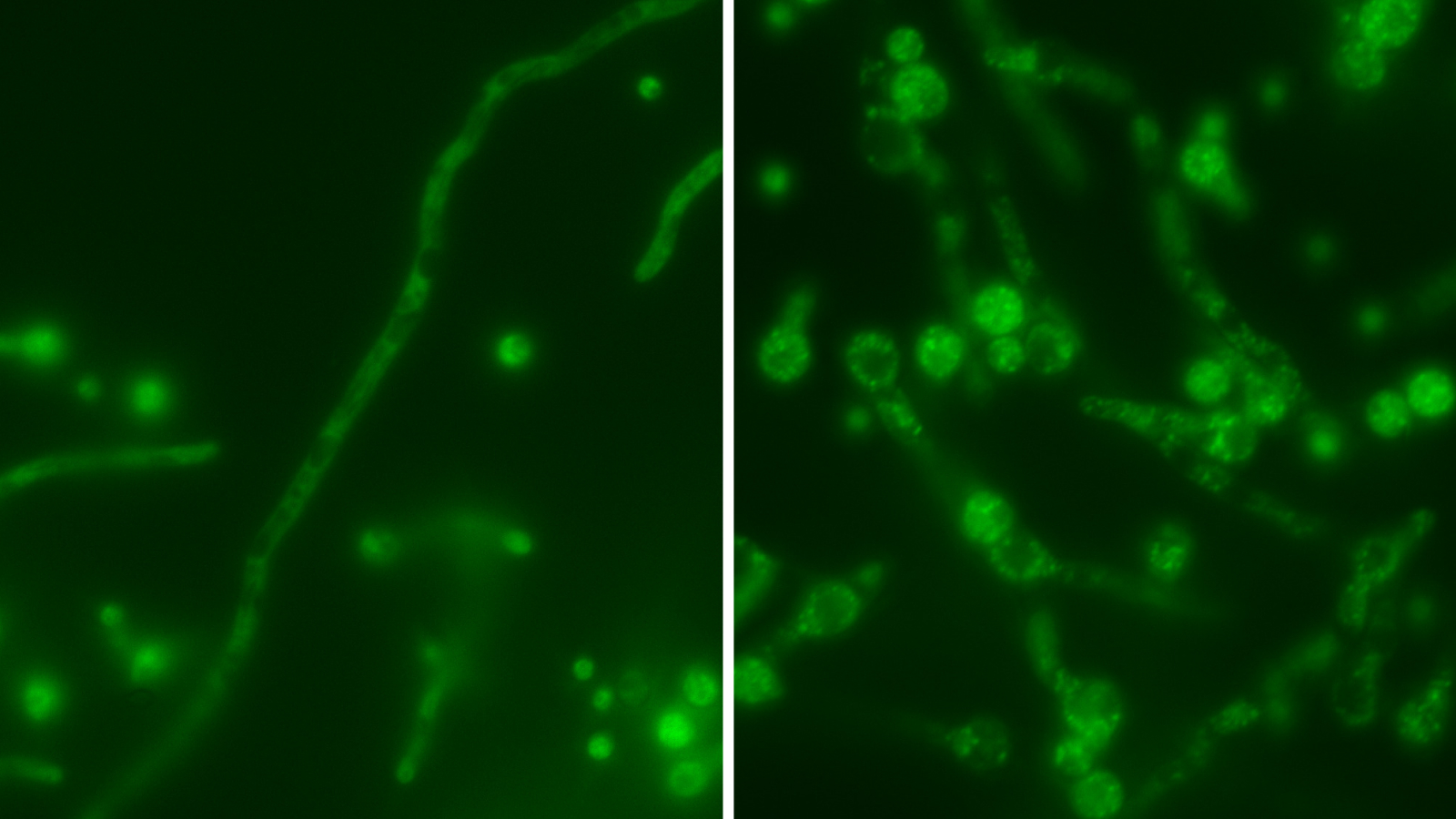‘Russian nesting doll’ virus hides inside a deadly fungus, making it even more dangerous to people
By Christoph Schwaiger
Copyright livescience

Skip to main content
Close main menu
Live Science
Sign up to our newsletter
View Profile
Search Live Science
Planet Earth
Archaeology
Physics & Math
Human Behavior
Science news
Life’s Little Mysteries
Science quizzes
Newsletters
Story archive
COVID vaccine poll
Ant clones members of another species
JWST takes best image yet
Science history: Gravitational waves detected
Best star projecter
Don’t miss these
Fungus that may have caused ‘King Tut’s curse’ shows promise in treating cancer
Viruses, Infections & Disease
How the battle between viruses and bacteria could help us beat superbugs
Viruses, Infections & Disease
Scientist’s cat helps discover a rare virus — yet again
Scraps of ancient viruses make up 40% of our genome. They could trigger brain degeneration.
Viruses, Infections & Disease
New viruses identified in bats in China
‘Universal’ cancer vaccine heading to human trials could be useful for ‘all forms of cancer’
Scientists reveal how viruses hidden in our DNA control our genes
Alzheimers & Dementia
Vaccines hold tantalizing promise in the fight against dementia
Gain-of-function research is not the ‘purview of mad scientists.’ It’s fundamental to biology.
Mystery of why sea stars keep turning into goo finally solved — and it’s not what scientists thought
Immune System
Mitochondria aren’t only the ‘powerhouses of cells’ — they also battle germs
Medicine & Drugs
8-year-old with rare, fatal disease shows dramatic improvement on experimental treatment
Medicine & Drugs
Scientists gave mice flu vaccines by flossing their tiny teeth — and it worked
Diet change could make brain cancer easier to treat, early study hints
Our gut bacteria can absorb and remove toxic ‘forever chemicals’ — at least in lab mice
Viruses, Infections & Disease
‘Russian nesting doll’ virus hides inside a deadly fungus, making it even more dangerous to people
Christoph Schwaiger
15 September 2025
A virus found lurking inside a deadly fungus may make the microbe even stronger and harder to kill when it infects people.
When you purchase through links on our site, we may earn an affiliate commission. Here’s how it works.
The concerning fungus Aspergillus fumigatus gains several survival advantages when carrying a specific virus, research finds. Here, the cultures shown on the right are infected with virus, while those on the left are uninfected.
(Image credit: Courtesy of Marina Campos Rocha)
A fungus flagged as a “critical” concern by the World Health Organization may have a secret weapon: a virus hidden inside it.
Now, a new study suggests that targeting this virus may offer a new strategy for treating these dangerous fungal infections in people.
The virus, called A. fumigatus Polymycovirus-1 (AfuPmV-1M), was known prior to the new research. But the study revealed that the virus appears to be giving the fungus Aspergillus fumigatus several key survival advantages.
You may like
Fungus that may have caused ‘King Tut’s curse’ shows promise in treating cancer
How the battle between viruses and bacteria could help us beat superbugs
Scientist’s cat helps discover a rare virus — yet again
A. fumigatus can infect people who breathe in its spores. This can cause short-term or long-term lung infections or an “invasive” disease that spreads beyond the lungs. While many people breathe in Aspergillus spores every day, usually only immunocompromised patients get sick, study lead author Marina Campos Rocha, a postdoctoral researcher at the Hebrew University of Jerusalem, told Live Science. People with lung disease are also vulnerable.
The fungus is responsible for about 2.1 million cases of invasive aspergillosis and 1.8 million cases of chronic lung infection per year, out of the 6.55 million invasive fungal infections that happen worldwide each year. The invasive infection has a mortality rate that ranges from 30% to 80% worldwide.
In the new study, published Aug. 14 in the journal Nature Microbiology, scientists studied mice that they infected with A. fumigatus, which itself was infected by the AfuPmV-1M virus in what Rocha described as a “Russian doll” scenario. The fungus used was originally isolated from the lung of a patient who had died from aspergillosis.
Related: In world 1st, virus spotted attached to 2nd virus
Sign up for the Live Science daily newsletter now
Get the world’s most fascinating discoveries delivered straight to your inbox.
Contact me with news and offers from other Future brandsReceive email from us on behalf of our trusted partners or sponsorsBy submitting your information you agree to the Terms & Conditions and Privacy Policy and are aged 16 or over.
The researchers showed that when they gave mice antiviral drugs, the rodents’ survival rate improved, they carried a lower fungal burden in their lungs, and they showed reduced viral levels compared with mice that weren’t given the medicine.
In other words, by solely targeting the virus, the researchers managed to reduce the burden of the fungal infection in mice, Rocha said. This seems to disagree with findings from an earlier study, published in 2020, which found the opposite effect — that targeting the virus inadvertently worsened the fungal infection. (Rocha noted that there could be several reasons for the divergent results, including the fact that each research team used different approaches to render their fungal strains virus-free.)
Norman van Rhijn, a research fellow at the Manchester Fungal Infection Group, said the finding uncovered by Rocha and colleagues was completely novel. “This has been a big step towards understanding the virulence capacity of this fungus and has the potential to broaden these findings in other human pathogens,” van Rhijn, who was not involved in the study, told Live Science in an email.
You may like
Fungus that may have caused ‘King Tut’s curse’ shows promise in treating cancer
How the battle between viruses and bacteria could help us beat superbugs
Scientist’s cat helps discover a rare virus — yet again
Rocha and her team found that the fungi exposed to antivirals reproduced less effectively and showed reduced melanin production; in many disease-causing fungi, melanin boosts virulence and the ability to survive in harsh environments.
The virus itself cannot harm mice or humans, since it needs specific receptors and proteins to bind to, and these are absent in the mammals, Rocha said. Each fungus-infecting virus is usually specific to one fungal species, she added.
“Like in the case of this one, it can only infect Aspergillus fumigatus,” Rocha said. “It’s not able to infect other fungi.”
The researchers think one way the virus helps the fungus thrive is by controlling some of the processes by which the fungus processes RNA, a genetic molecule involved in making proteins. The virus somehow improves the fungus’ stress responses and protein synthesis, thus strengthening survival in hostile conditions. They also saw that human immune cells found it harder to kill virus-infected strains of the fungus, compared with uninfected strains.
RELATED STORIES
—New fungal infection discovered in China
—Caffeine may help bacteria resist antibiotics, study finds
—’The most critically harmful fungi to humans’: How the rise of C. auris was inevitable
If the antivirals used to target AfuPmV-1M in the mice work as effectively in humans, future therapies could use the drug to weaken the fungus enough for the immune system or antifungal drugs to clear it from the body, the study authors think.
Rocha suspects other fungal pathogens that infect people may also be infected with similar viruses that boost their resilience. Together with her colleagues, she is investigating the infection mechanisms involved in infected and uninfected fungi.
“Our article represents only the initial step of this investigation,” she told Live Science. “Our broader goal is to provide a more comprehensive explanation of how the process unfolds at the molecular level.”
This article is for informational purposes only and is not meant to offer medical advice.
Christoph Schwaiger
Social Links Navigation
Live Science Contributor
Christoph Schwaiger is a freelance journalist, mainly covering health, technology, and current affairs. His stories have been published by Live Science, New Scientist, BioSpace, and the Global Investigative Journalism Network, among other outlets. Christoph has appeared on LBC and Times Radio. Additionally, he previously served as a National President for Junior Chamber International (JCI), a global leadership organization, and graduated cum laude from the University of Groningen in the Netherlands with an MA in journalism.
You must confirm your public display name before commenting
Please logout and then login again, you will then be prompted to enter your display name.
Fungus that may have caused ‘King Tut’s curse’ shows promise in treating cancer
How the battle between viruses and bacteria could help us beat superbugs
Scientist’s cat helps discover a rare virus — yet again
Scraps of ancient viruses make up 40% of our genome. They could trigger brain degeneration.
New viruses identified in bats in China
‘Universal’ cancer vaccine heading to human trials could be useful for ‘all forms of cancer’
Latest in Viruses, Infections & Disease
Diet change could make brain cancer easier to treat, early study hints
Have you gotten this year’s COVID vaccine?
‘Your fear is well-founded’: How human activities have raised the risk of tick-borne diseases like Lyme
‘We have basically destroyed what capacity we had to respond to a pandemic,’ says leading epidemiologist Michael Osterholm
US reports its first New World parasitic screwworm infection in decades
Vaccines hold tantalizing promise in the fight against dementia
Latest in News
‘Russian nesting doll’ virus hides inside a deadly fungus, making it even more dangerous to people
3,300-year-old ancient Egyptian whistle was likely used by police officer tasked with guarding the ‘sacred location’ of the royal tomb
Science news this week: NASA finds best evidence of life on Mars and scientists invent visible time crystals
Astronomers use rare ‘double zoom’ to view black hole corona in unprecedented detail
350-year-old mummified head from Bolivia isn’t what it seems
‘Almost like science fiction’: European ant is the first known animal to clone members of another species
LATEST ARTICLES
Diet change could make brain cancer easier to treat, early study hints
Suunto Run fitness tracker review — Light, feature-packed and reasonably priced
New EV battery tech could power 500-mile road trips on a 12-minute charge
TRAPPIST-1e might have an atmosphere, JWST hints
The best star projector we’ve tested is 38% cheaper on Amazon, taking it to one of its lowest-ever prices
Live Science is part of Future US Inc, an international media group and leading digital publisher. Visit our corporate site.
Contact Future’s experts
Terms and conditions
Privacy policy
Cookies policy
Accessibility Statement
Advertise with us
Web notifications
Editorial standards
How to pitch a story to us
Future US, Inc. Full 7th Floor, 130 West 42nd Street,
Please login or signup to comment
Please wait…



